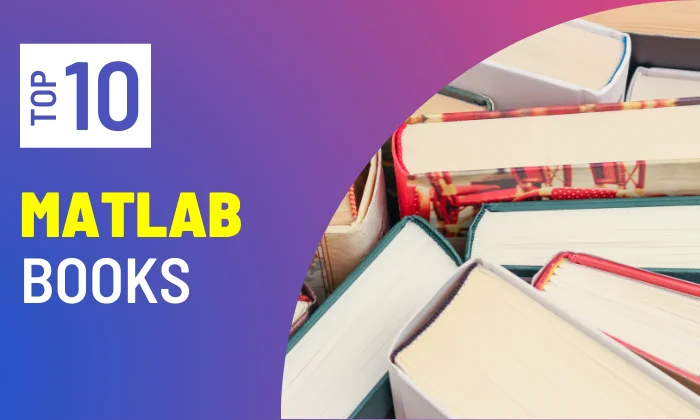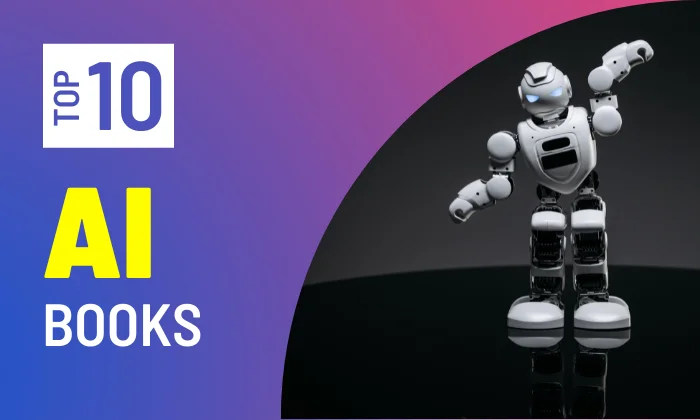These are the top 10 Matlab books that will help you learn and implement Matlab.

1. MATLAB For Beginners: A Gentle Approach
by Peter I. Kattan
This book is meant for people who are learning MATLAB for the first time. The book is meant mostly for beginners and students. Furthermore, the book is appropriate for students and researchers in a broad variety of fields, from engineers and scientists to biologists and environmental scientists. The most important purpose of this book is to educate students on MATLAB and its powerful and simple computational capabilities. The book covers a variety of topics, including arithmetic operations, variables, and an introduction to calculus. There are also over 230 exercises for students to practice at the end of each chapter.
2. Getting Started with MATLAB: A Quick Introduction for Scientists and Engineers 7th Edition
by Rudra Pratap
One of the most extensively used tools in the engineering industry today is MATLAB, a software program for high-performance numerical computing and visualization. Its interactive environment, which includes hundreds of built-in functions for technical computation, graphics, and animation, is the source of its wide popularity. In addition, MATLAB’s high-level programming language allows for easy extensibility.
This book is well-written for beginners who want to learn and master this language. This seventh version of the extremely renowned book for MATLAB, enhanced by amusing and appealing pictures, adopts a casual, approachable writing style that educates users on how to enjoy using MATLAB.
3. MATLAB: An Introduction with Applications, 6th Edition
by Amos Gilat
This handbook is targeted at students who are new to MATLAB and have little or no expertise with computer programming. It can be used as a textbook in first-year engineering courses or as a source in advanced science and engineering courses that introduce MATLAB as a problem-solving tool.
This wonderful book is well-known for its just-in-time learning method, which provides students with an understanding just when they require it. The 6th Edition gradually explains the most recent MATLAB features. The book provides a plethora of sample problems in mathematics, physics, and engineering that are similar to those experienced by beginning MATLAB users.
4. MATLAB: A Practical Introduction to Programming and Problem Solving 5th Edition
by Stormy Attaway Ph.D. Boston University
The fifth edition of the masterpiece has been revised to incorporate the capability of MATLAB R2018a, including the addition of local functions in scripts, the new string type, coverage of recently released utilities to import data from online sites, and revisions to the Live Editor and App Designer. This book teaches the reader through both programming and built-in functions so that they may take full advantage of MATLAB’s broad capacities for solving engineering and scientific challenges. This book begins with basic programming principles like variables, assignments, and selection statements, then moves on to loops, and finally solves problems using both the programming concept and the power of MATLAB.
5. MATLAB For Dummies 2nd Edition
by John Paul Mueller, Jim Sizemore
This book takes you through the installation, presentation, and automation of this complicated computational language. This book contains everything you need to get started manipulating and plotting your data using MATLAB, a popular and sophisticated computational program. This guide is a detailed reference to the principles of MATLAB, which has quickly become the top data tool. It will assist you in learning the essentials of the MATLAB language, such as syntax, operators, and data types. It will also assist you in learning how to visualize your data by plotting graphs in 2D and 3D. This book provides a clear, and complete guide to get the most out of your data with MATLAB, which is a vital tool of the analysis arsenal.
6. Learning to Program with MATLAB: Building GUI Tools 1st Edition
by Craig S. Lent
The book is written for educators who love teaching introductory programming principles using MATLAB. Because many students have difficulty implementing the principles that underpin excellent programming practice. This textbook introduces fundamental computer programming principles such as loops, functions, arrays, and basic data structures.
This book is revised on the observation that student learning is boosted when students create the GUI (graphical user interface) tool, establish the computational model, and implement the visualization of outcomes. The book sequence begins with text-based programs and progresses to programs that generate graphics, resulting in a focus on graphical user interface tools.
7. Programming for Computations – MATLAB/Octave
by Svein Linge, Hans Petter Langtangen
This book is made up of simple language that provides a gradual introduction to the fundamental mathematics and computer science concepts that underpin MATLAB programming. It also concentrates on detailing how to write programs to answer mathematical issues, whether numerical or graphical. It guides the reader through the process of creating simple codes for complex situations to save time.
It also focuses on the validation process and how to incorporate them into automated test frameworks. The book lays out the quickest way for students to develop simple programs to solve basic mathematical problems using numerical approaches in engineering and science classes. The focus is on generic algorithms, clean program design, the usage of functions, and automated verification tests.
8. MATLAB for Engineers 5th Edition
by Holly Moore
In this book, the author introduces learners to the MATLAB coding language. The text is meant to meet students where they are in terms of mathematical and computer sophistication. The book describes several ways to tackle engineering problems by using MATLAB. Some chemistry and physics principles are explained to illustrate a consistent problem-solving process.
To understand this textbook, students should be familiar with college algebra and basic trigonometry because these are the basis for MATLAB. The textbook provides brief background information on stats and matrix algebra. Students who know advanced mathematics will find sections on calculus and differential equations at the end of the book.
9. MATLAB for Brain and Cognitive Scientists (The MIT Press) 1st Edition
by Mike X Cohen
The book includes both instructional material and detailed explanations of MATLAB code, as well as programming tips and tricks. The purpose of this book is to teach readers how to program data analysis in neuroscience and psychology.
Readers will learn not only how to program, but also how not to program, by looking at instances of terrible code that they can fix or better. There are exercises at the end of each chapter that test and develop the abilities taught in the book. This book is a must-have for both students and instructors, whether in the classroom or for self-study.
10. Applied Numerical Methods with MATLAB for Engineers and Scientists 4th Edition
by Steven Chapra
Students who want to learn and apply numerical methods to address problems in engineering and science can benefit from this textbook using MATLAB. This book has so many practical examples which help the reader to understand the core of MATLAB programming. Their skills will automatically enhance after going through such practical problems.
As a result, rather than being motivated by mathematics, the approaches are motivated by issues. However, sufficient theory is offered so that students have an understanding of the procedures and their flaws. Problems are randomized to avoid answer sharing and may include a “multi-step solution” to aid students’ learning if they encounter trouble.
Stay tuned to AiHints for more insightful tutorials on web development, programming, and artificial intelligence. Happy coding!


